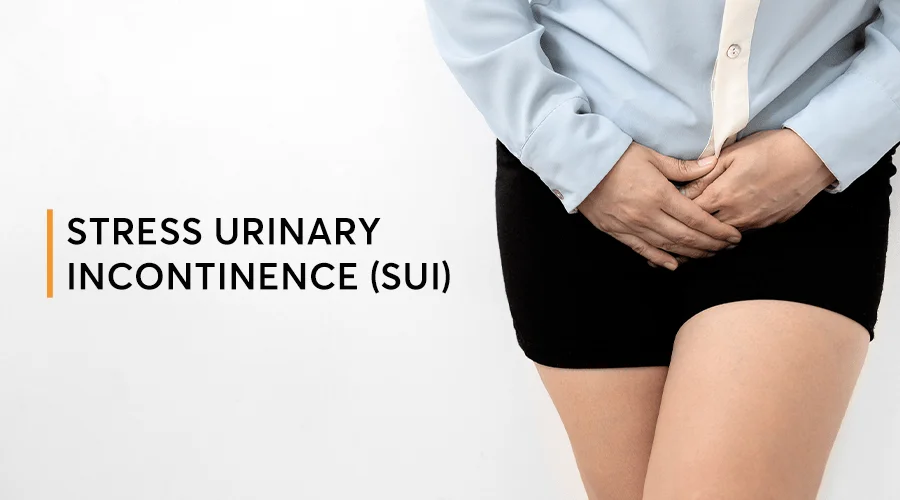Stress Urinary Incontinence
Home / Stress Urinary IncontinenceStress Urinary Incontinence (SUI)

Stress Urinary Incontinence (SUI) occurs when urine leaks out as a result of sudden pressure on the bladder and urethra, causing the sphincter muscles to briefly open. Stress incontinence (SI) is the most common type of incontinence in women, affecting women of all ages. Women over the age of 50 are especially vulnerable. Furthermore, women who have recently given birth are more likely to experience stress incontinence.
Pressure from sudden forceful activities, such as exercise, sneezing, laughing, or coughing, can cause mild SUI. If your SUI is severe, you may also leak when performing less forceful activities such as standing up, walking, or bending over. Urinary “accidents” of this type can range from a few drops to enough urine to soak through your clothes.

Urgency incontinence and overactive bladder are not the same as stress incontinence (OAB). Urgency incontinence, also known as OAB, occurs when your bladder muscle contracts, causing a sudden urge to urinate before you can get to the bathroom. Women are far more likely than men to experience stress incontinence.
What Causes Stress Urinary Incontinence?
The bladder and urethra are supported by the pelvic floor. SUI can occur if this area is stretched, weakened, or damaged. This can be caused by pregnancy and childbirth. Chronic coughing, nerve injuries to the lower back, or pelvic surgery (such as prostate cancer surgery) can all weaken the muscles.
What Are the Symptoms of Stress Urinary Incontinence?
The primary symptom of SUI is when urine leaks out during any activity that causes an increase in abdominal pressure. The leakage could be as small as a drop or two, a “squirt,” or even a stream of urine. This can occur while you are:
- Sneezing
- Coughing
- Laughing
- Jumping
- Exercising
- Doing Heavy Lifting
- Engaging In Sexual Intercourse
Risk Factors in Stress Urinary Incontinence
The following factors increase the likelihood of developing stress incontinence:
- Age. Physical changes that occur as you age, such as muscle weakness, may increase your risk of developing stress incontinence. Stress incontinence, on the other hand, can occur at any age.
- Type of childbirth delivery. Women who have had a vaginal delivery are more likely than women who have had a caesarean section to develop urinary incontinence. Women who have had a forceps delivery in order to have a healthy baby more quickly may be at a higher risk of stress incontinence. Women who have had a vacuum-assisted delivery do not appear to be at increased risk for stress incontinence.
- Weight. Overweight or obese people are more likely to experience stress incontinence. Excess weight puts strain on the abdominal and pelvic organs.
- Previous pelvic surgery. The muscles that support the bladder and urethra can be weakened by hysterectomy in women and prostate cancer surgery in men, increasing the risk of stress incontinence.
Physiotherapy In Stress Urinary Incontinence
Physiotherapy is a safe and effective treatment for stress/urge incontinence. It will reduce your symptoms and if started in the early stages can completely cure you. This treatment has no side effects so it should be the first choice of treatment. The main aim of physiotherapy is;
- Control over symptoms
- Reduce the dependency on medicines/pads
- Reduce the chances of surgery.
After the assessment and knowing the history of the patient, we at Delhi Physio Care will tailor therapy that best suits your needs. Incontinence is more seen in women, so it is categorized under women’s health sometimes, though we see a lot of men facing the problem too.
The role of the physiotherapist is ;
- Increase the strength, coordination and endurance of the pelvic floor muscles.
- Strengthen the abdominal and lumbar muscles.
- Bladder/bowel training
- Tips on fluid management and diet modification.
The pelvic floor muscles are like a hammock extending from sacrum(tailbone) to pubic
bone, in front of abdomen. These are the muscles that need to be trained and exercised. It is important to make the patient aware of these muscles first. This can be done by teaching to first relax the other adjoining muscles like the abdominals and the muscles of the thigh. Once these muscles are relaxed, contract the pelvic floor muscles which are exactly like to hold urine or stool. These are called the KEGEL exercises. They are taught in lying, sitting, standing, walking….in all positions. You will be taught to do slow and fast squeezes as many times as possible. It is important to not hold your breath while doing them. Talking while exercising helps to breathe normally.
The posture is important while doing these exercises; eg. When doing kegel sitting, sit straight. Avoid using the core and the back. These exercises not only train and strengthen the pelvic floor muscles but also improves bladder control.
Electric muscle stimulation is clinically very useful for pelvic floor muscles. It not only makes the patient more aware of the muscles and its function but also fastens the progress of strengthening. It is possible to do the exercises along with the stimulation for as long as 30 minutes without the muscles getting fatigued. We teach the patient to actively contract the pelvic floor muscles along with the stimulation. It overcomes the bladder leakage that occurs with lost automatic activity. This aids to close the urinary tube/ urethra more effectively. Learn to lift and firm the muscles to withstand downward pressure from the abdomen. Lift and squeeze urethral/ vaginal and anal muscles. We can progress by learning to contract these muscles and then coughing or doing other activities that cause downward pressure on the pelvic floor.
Kegel is always combined with the knack principle which is a strong and well timed contraction of these muscles.
Remember; “ Squeeze before you Sneeze.” Anything that causes a downward pressure like coughing, sneezing or lifting heavy objects… tighten and lift up the pelvic floor.
Don’t strain during bowel movements. Constipation worsens the symptoms.
Identify the food items that aggravate the symptoms. Eg. Caffeine is considered a bladder irritant.
Bladder retraining is a gradual progress. It is extending the time between visits to the toilet. It could be as less as 1-2 minutes initially. A few techniques can be tried to achieve this.
- Mental distraction
- Perform quick pelvic floor muscle contractions
- Avoid precautionary use of the toilet( just in case if you have to go out)
The patient starts feeling some difference in a couple of sessions, but it would take about 6-8 weeks of regular exercises with electric muscle stimulation and bladder retraining to see improvement like fewer leakage episodes and reduced frequency of urination.
As said earlier, it is a very safe treatment with no side effects. We see a 70-80% success rate in avoiding or delaying the surgery. Patience and regularity makes the treatment successful.
Urinary incontinence; It doesn’t have to control your life. Find out your treatment options today!
Myths and Facts



Quick Enquiry
Send us a message with your contact details and one of our staff will contact you right away.
TREATMENTS
BOOK AN APPOINTMENT
GENERAL ENQUIRIES
235, Avtar Enclave,Paschim Vihar,Delhi – 110063
Supraspinatus Tendonitis Treatment FAQ’s
Supraspinatus Tendonitis is a common condition that occurs due to constant wear and tear of the supraspinatus tendon or due to injury.
Some common treatments for the supraspinatus tendonitis condition include-
- Taking Proper Rest
- Anti-Inflammatory Medication
- EPAT Therapy Treatment
- Kinesiology Tape (KT Tape) or Shoulder Sling
- Physical Therapy
- Corticosteroid Injection
- Surgery
Supraspinatus tendinopathy is a common medical condition, especially after mid-age. However, it can be avoided with some precautions. One should avoid extreme stress on the shoulders. Physical activities like sports (tennis, baseball, volleyball) and exercises involving movement of upper arms behind the torso should be minimalized.
If you are suffering from supraspinatus tendonitis, you must visit a physiotherapist for a thorough assessment of your shoulder. A physiotherapist will examine your problem and identify the problem area and the factors contributing to it. Physical therapy will help in supraspinatus tendonitis by following-
- Improve your shoulder strength- By exercises involving your shoulder and rotator cuff
- Improve your posture- Suggesting the right posture to improve the subacromial space.
Supraspinatus tendon takes time to heal and the time may vary from a week to few months depending upon the condition. During this duration, the patients are strictly advised to avoid any physical activity that might have been attributed to the supraspinatus tendon condition.
